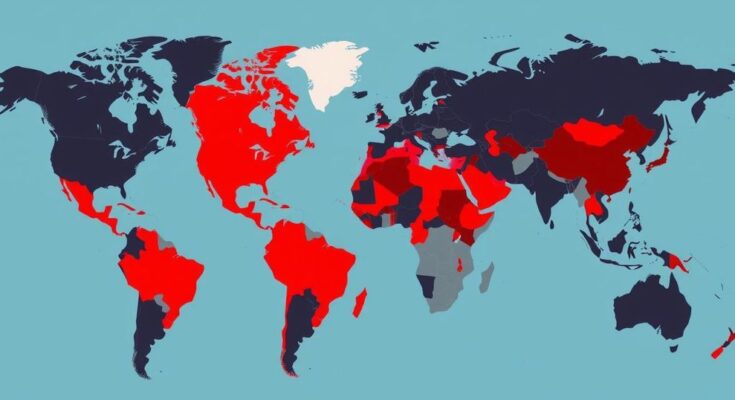The U.S. Department of State has issued heightened travel advisories for various countries under Level 4, reflecting significant safety concerns due to crime, political instability, and violence. These advisories impact destinations such as Afghanistan, the Democratic Republic of the Congo, Lebanon, and Ukraine, suggesting that American travelers reconsider their plans as spring break approaches. Awareness and adherence to travel advisories are crucial for ensuring safety during travel to high-risk areas.
The U.S. Department of State has updated travel advisories for a number of popular spring break destinations including Russia, Jamaica, Colombia, and others. These advisories range from Level 3 (Reconsider Travel) to Level 4 (Do Not Travel) due to increasing threats such as crime, political instability, gang violence, and terrorism. This shift will likely impact how American travelers perceive these traditionally favored tourist spots as spring break approaches.
These destinations have long been popular for their cultural diversity, picturesque coastlines, and lively atmospheres. However, recent warnings highlight a surge in violent crime, such as armed robbery and kidnapping, particularly in tourist-heavy areas. These alarming trends have prompted the U.S. government to release safety warnings, stressing the heightened risks for both tourists and local residents.
Many countries are currently under Level 4 travel advisories, indicating that the safety risks are too significant for American visitors. This advisory signifies that ongoing conflict, political unrest, or other extreme conditions make these locations exceedingly dangerous. As we approach 2025, the frequency of such warnings underscores the escalating security threats worldwide.
A review of nations under a Level 4 advisory reveals Afghanistan as a critically risky area because of persistent violence, including kidnappings, terrorist attacks, and a lack of healthcare resources. The Department of State strongly advises against any American travel to Afghanistan until further notice due to these alarming conditions.
The Democratic Republic of the Congo (DRC) remains plagued by conflict, particularly in the eastern regions, where armed groups frequently engage in acts of violence. Travelers face numerous risks, including kidnappings and various health crises, further reinforcing the warning against travel to the DRC.
Lebanon’s current political instability and economic crisis have deteriorated conditions for travelers. Despite its rich history as a travel destination, ongoing protests and the threat of terrorism make visiting Lebanon highly discouraged by the U.S. government.
The Central African Republic experiences significant violence due to ongoing armed conflicts between various factions, posing an extreme risk of being caught in crossfire or abduction. Accepting travel to this region could lead to dire consequences and is therefore strongly discouraged.
Belarus is marked by political oppression and potential risks for U.S. travelers, increasing the likelihood of harassment or legal issues. Continued political dissent presents added dangers, making it another high-risk area for travel.
Iraq is similarly categorized as a high-risk travel area due to the ongoing presence of militant groups such as ISIS, resulting in a high likelihood of violent crime and terrorist acts. Thus, the U.S. government advises against travel to Iraq given these security concerns.
The ongoing conflict in Ukraine, particularly since the Russian invasion, presents severe risks for travelers. The ongoing violence has resulted in massive displacements and hazardous conditions for those attempting to visit, making U.S. travel to the region inadvisable.
Venezuela’s severe political and economic crisis correlates with safety concerns, including rampant violent crime, making it a risky destination for travelers. Similarly, Haiti’s challenges with gang violence and political instability create an unsafe environment for tourists.
Iran continues to pose risks due to political unrest and potential detentions for foreign nationals, leading the U.S. government to issue a Level 4 advisory against travel there.
Notably, these countries share commonalities of ongoing conflict and political instability, necessitating the issuance of travel bans by the U.S. Department of State. While some travelers may choose to ignore these advisories, it is paramount to stay informed about safety protocols and to heed warnings.
Travelers are encouraged to remain updated on conditions by consulting the U.S. State Department’s travel advisory website and considering enrollment in the Smart Traveler Enrollment Program. It becomes essential to weigh safety risks seriously while planning any trips to high-risk areas.
The implications of these Level 4 advisories greatly affect the travel industry, prompting adjustments from airlines, tour operators, and travel agencies to stay aligned with updated security assessments. Some sectors, such as travel insurance, may experience increased demand for coverage related to emergencies as a direct result of these warnings.
Consequently, while the popularity of these destinations persists, it is crucial for travelers to prioritize their safety by planning trips with due diligence. With the approach of spring break, awareness of increased security risks is vital for American travelers as they navigate popular yet dangerous destinations.
In conclusion, as the spring break season approaches, travelers must remain vigilant regarding the heightened safety risks associated with numerous destinations under Level 4 travel advisories. The increasing prevalence of such warnings emphasizes the need for informed decision-making and diligence in travel planning. The travel industry will likely adapt to these advisories, urging tourists to prioritize their safety and make well-informed choices when considering travel to risky regions.
Original Source: www.travelandtourworld.com




